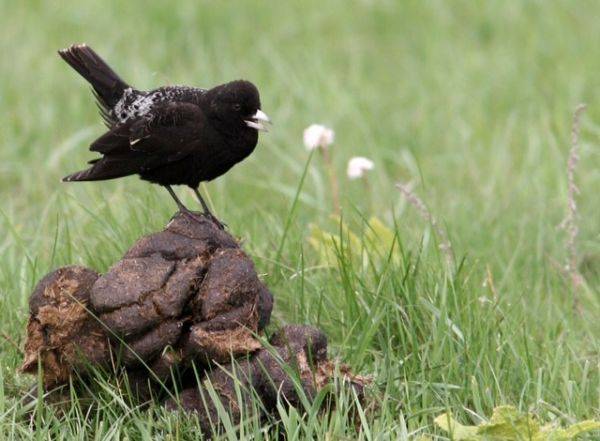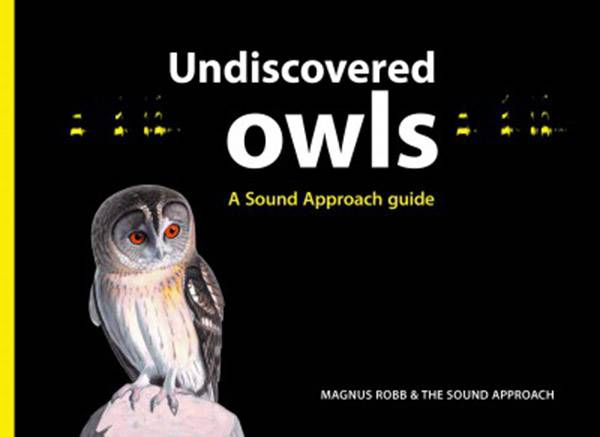This review was first published on Dutch Birding website and is reproduced here with the consent of the web-editors of DB and the author.
Dutch Birding website: https://www.dutchbirding.nl/..checklist_of_the_species_and_subspecies
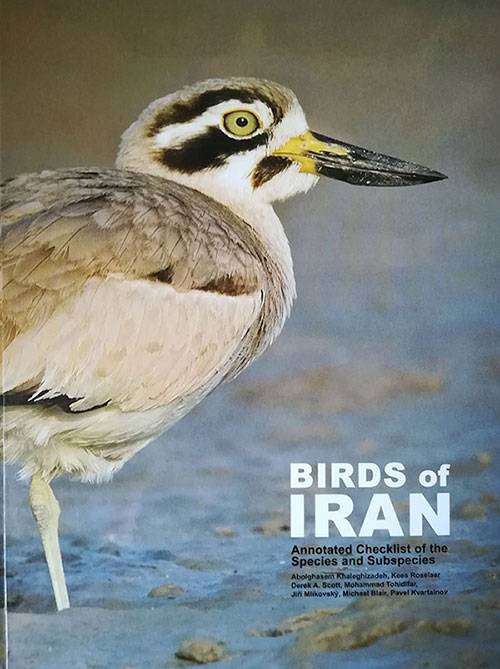
Iran is one of the largest countries in the Western Palearctic (WP). It was not included in the WP by Cramp & Simmons (1977), but most authorities do include it in the ‘greater’ WP (Mitchell 2017, van den Berg 2018, Shirihai & Svensson 2018). As Iran’s avifauna consists largely of WP species, its inclusion within the region is well-founded (cf Martins & Hirschfeld 1998, Roselaar 2006, Ullman 2009).
Because of its large size (more than 1,6 mln km2) and location, the composition of Iran’s birdlife is highly diverse. The country’s position between the Caspian Sea in the north and the Persian Gulf, the Gulf of Oman and the Indian Ocean in the south, together with the high mountains (Zagros in the west and Elburs in the north) and two (almost uninhabited) salt deserts, makes for an impressive diversity of birdlife. For most WP birders, the country is very important, mysterious and often difficult to get to. Iran has a large number of species that can be seen only (or almost only) in the WP. The country is known to be a very important wintering area for waterbirds, eg c 3 million such birds were counted in January 2003 (van Diek et al 2004, Winkel et al 2010). Recently, the more than 7600 Lesser White-fronted Geese Anser erythropusdiscovered in Tabriz represented the highest count in recent times for any WP wintering site (cf DB 40: 46, 2018).
Information on the status of birds of Iran is scattered in many publications, so it is with great pleasure to welcome a book that presents an overview of all species and subspecies of birds recorded in this country up to the beginning of 2017. It is the first such publication for over a century following the checklist by Nikolay Alekseyevich Zarudny in 1911. The authors of the 2017 book have dedicated their book to this Russian researcher of the former Persia.
During their preparations for this book, the authors spent a great deal of time gathering literature on Iranian birds and checking databases and museum specimens for confirming the type localities of Iranian taxa. Short introductory chapters contain concise information about material and methods, definition of status and abundance categories, geographical regions and taxonomic terms. The main part of the book (bilingual, in English and Persian) is an annotated list of the 551 species and 535 subspecies of birds recorded in Iran, in accordance with the IOC World Bird List (version 5.4; with the exception of a few species). Besides brief information on eg the global and national range and conservation status, the species descriptions include information on status in Iran, taxonomic notes, museum specimens, references and comments.
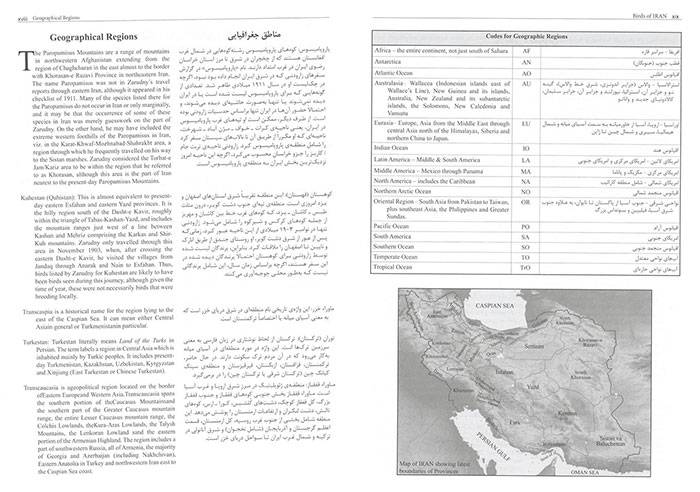
Status descriptions contains rather general information about the range and period of occurrence of a given species, most often in relation to provinces. Information with regard to vagrants is quite accurate, especially for extremely rare ones both on the national and WP scale (date and place). The authors have paid meticulous attention to the taxonomy of both of species and subspecies, citing literature references for all taxa, and often commenting on individual taxonomic decisions. A lot of space has been given to descriptions of subspecies of birds recorded in Iran. In many cases, the taxonomy (after IOC) in this book differs from that used in eg HWPB or the DB bird names. For example: Asian Short-toed Lark Alaudala cheleensis is treated as a full species, Turkestan Tit Parus bokharensis and Cinereous Tit P cinereus as subspecies of Great Tit P major, Black-headed Penduline Tit Remiz macronyx remains a full species (cf Barani-Beiranvand et al 2017, Shirihai & Svensson 2018) etc. It reflects the great diversity in approach by the most important sources (Birdlife, IOC, HWPB, DB) and can be a headache for many WP birders. It’s hard to expect a single approach to this issue, but that’s a topic for another (long) story…
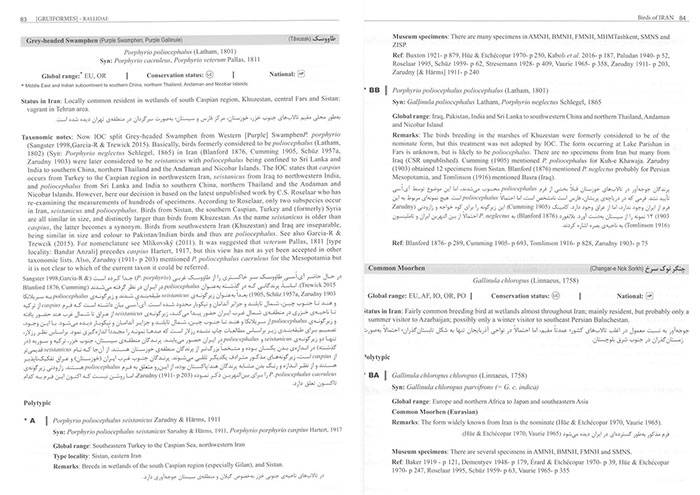
What I personally find the most interesting in a book like this, is the information about WP specialities and the extremely rare vagrants at a regional scale. From a western birders perspective, the list of such specialties is very long: African Sacred Ibis Threskiornis aethiopicus (an uncommon winter visitor and possibly a rare breeding bird in the wetlands of Khuzestan), Goliath Heron Ardea goliath (a rare resident mainly in the mangrove areas on the S coast), African Darter Anhinga rufa (a rare winter visitor to the wetlands of Khuzestan), Crested Honey Buzzard Pernis ptilorhynchus (a fairly common winter visitor to Hormozgan and S Baluchestan), Tawny Eagle Aquila rapax (a local resident in S Persian Baluchestan), White-eyed Buzzard Butastur teesa (an uncommon resident in coastal lowland regions), Siberian Crane Grus leucogeranus (now only one individual wintering in Mazandaran on the Caspian coast – the last wild bird of this species in the WP; cf Ławicki & Tizrooyan 2018), Great Stone-curlew Esacus recurvirostris (an uncommon resident along the coast of Hormozgan and Baluchestan), Caspian Plover Anarhynchus asiaticus (a fairly common migrant in W Iran; the first breeding record was in Golestan in 2017 – cf DB 40: 48, 2018), Great Knot Calidris tenuirostris (a locally fairly common winter visitor to the coast of Hormozgan), Asian Koel Eudynamys scolopaceus (probably a rare resident in S Baluchestan and Hormozgan), Turkish Fish Owl Bubo semenowi (rediscovered in 2004 by a team of Dutch birders; currently a rare resident in at least six provinces; cf DB 39: 348, 2017, 40: 263, 2018), Omani Owl Strix butleri(discovered in 2015; possibly a rare resident; cf Musavi et al 2016, DB 40: 263, 2018), Spotted Owl Athene brama (a fairly common resident, replacing Cucumiau A noctua in S lowlands), Sind Woodpecker Dendrocopos assimilis (a fairly common resident in S Baluchestan and Hormozgan, where it hybridizes with Syrian Woodpecker D syriacus), Bay-backed Shrike Lanius vittatus (a fairly common summer visitor to Baluchestan and Hormozgan), Pleske’s Ground Jay Podoces pleskei (endemic; a locally fairly common resident in central deserts east to the border with Afghanistan and south to N Baluchestan), Mesopotamian Crow Corvus capellanus (a fairly common resident in the lowlands of Khuzestan), Grey Hypocolius Hypocolius ampelinus (a locally common summer visitor to the lowlands of S Iran, recently found breeding in Dasht-e Kavir, also a rare in winter in S Iran), Turkestan Tit (an uncommon resident of lowlands in NE Khorasan), Cinereous Tit (a resident in NE Iran), Caspian Tit Poecile hyrcanus (a fairly common resident of the S Caspian forests from Gilan to Golestan), Black-headed Penduline Tit (an uncommon resident in the S Caspian region), Sand Lark Alaudala raytal (a fairly common resident in the coastal lowlands of S Iran), Plain Leaf Warbler Phylloscopus neglectus (a fairly common summer visitor to the upper shrub zone in some massifs and also a passage migrant throughout Iran and winter visitor to the S lowlands), Basra Reed Warbler Acrocephalus griseldis (an uncommon and local summer visitor to the marshes of Khuzestan), Afghan Babbler Turdoides huttoni (a common resident in S Iran), Oriental White-eye Zosterops palpebrosa (a rare and local resident in the mangroves of Hormozgan; cf Zekhuis & Ghasemi 2009), Pied Bush Chat Saxicola caprata (a fairly common summer visitor to E Iran), Sistan Scrub Sparrow Passer yatii (a locally common resident in the wetlands and oases of the Sistan basin), White-winged Grosbeak Mycerobas carnipes (an uncommon resident in E Alborz and in Kopet Dagh in N Khorasan) and Red-headed Bunting Emberiza bruniceps (a common summer visitor to NE Iran, where it hybridizes with Black-headed Bunting E melanocephala; cf Gholamhosseini et al 2017). Undoubtly an impressive list!

The list of extreme WP vagrants found in Iran is equally spectacular (mainly from the Oriental region): Middendorff’s Bean Goose A middendorffii (collected on 3 November 1898; the only WP record), Woolly-necked Stork Ciconia episcopus (three birds on 19 March 1901; the only WP record), Himalayan Vulture Gyps himalayensis (27 April 2007 and 8 December 2010; the first and second for WP), Eastern Marsh Harrier Circus spilonotus (5 October 1898 and 11 November 1900 – both collected by Zarudny; the only WP records), Upland Buzzard Buteo hemilasius (collected on 30 November 1900; the only WP record), Far Eastern Curlew Numenius madagascariensis (2 October 1898; one of two WP records), Solitary Snipe Gallinago solitaria (only two records since 1903; but formerly a rare winter visitor and passage migrant – few specimens were collected in October), Indian Skimmer Rynchops albicollis (collected on 14 March 1901; one of two WP records), Brown-headed Gull Chroicocephalus brunnicephalus (four records), River Tern Sterna aurantia (two photographed on 18 January 2005; the only WP record), Red Turtle Dove Streptopelia tranquebarica (two birds on 29 January 1975 and again two on 8 March 2000 may refer to escapes), Red-necked Falcon Falco chicquera (collected on 11 July 1898; the only WP record), Laggar Falcon F jugger (9 April 1972; the only WP record), Black-naped Monarch Hypothymis azurea (photographed on 13 February 2011; the only WP record), Large-billed Crow C macrorhynchos (14 November 1900; the only confirmed WP record, but possibly formerly a rare resident in NE Khorasan), Grey-throated Martin Riparia chinensis (three records), Bank Myna Acridotheres ginginianus (a flock of 10 individuals on 11 April 2017; the first wild-origin record in WP), Brahminy Starling Sturnia pagodarum (October 2014 and February 2016), Verditer Flycatcher Eumyias thalassinus (28 March 2001; the only WP record), Ultramarine Flycatcher Ficedula superciliaris (two birds on 25 April 2009; the only WP record), Blue Whistling Thrush Myophonus caeruleus (collected on 28 November 1900; the only WP record) and Paddyfield Pipit Anthus rufulus (two records in December 2010; the first and second for WP) (for details see: Roth et al 2005, Foekens & Schelvis 2006, Scott 2008, Roselaar & Aliabadian 2009, Cheraghi & Tohidifar 2010, Khaleghizadeh et al 2011, Alieslam 2014, Ayé et al 2014, Shokouhi et al 2018).
Despite the growing activities of local birders, Iran still remains a relatively poorly researched country. This is mainly because of the still small number of Iranian birdwatchers and the very small number of foreign birders visiting the country. It means that we can continue to anticipate on many interesting discoveries in Iran, especially species of uncertain status such as Common Buttonquail Turnix sylvaticus(possibly a rare resident in S Baluchestan, but the last confirmed record in 1975), Yellow-eyed Pigeon Columba eversmanni (probably a rare resident and winter visitor in NE Iran), Sykes’s Nightjar Caprimulgus mahrattensis (probably a resident in E Hormozgan and Baluchestan; the last record in 1978), White-rumped Vulture G bengalensis (perhaps formerly a rare resident in Hormozgan and Baluchestan; last recorded in 1972), Pallas’s Fish Eagle Haliaeetus leucoryphus (formerly an uncommon winter visitor, now only a vagrant), White-winged Woodpecker D leucopterus (perhaps formerly a rare resident in extreme NE Iran), Scaly-bellied Woodpecker Picus squamatus (formerly a rare resident in E Iran, but not recorded since c 1900), White-crowned Penduline Tit R coronatus (formerly a rare and irregular winter visitor to E Iran, but last recorded in 1975), Hume’s Short-toed Lark Calandrella acutirostris (possibly a local summer visitor to NE Iran, but last recorded in 1973), Saxaul Sparrow P ammodendri (possibly a rare resident in the Hari Rud valley in NE Iran; cf Ayé 2008), Sind Sparrow P pyrrhonotus (probably a rare resident in SE Baluchestan, the last record in 1975), Zarudny’s Sparrow P zarudnyi (perhaps formerly an uncommon resident in E Iran, but last recorded in 1901) and White-capped Bunting E stewarti (possibly a rare summer visitor to N Khorasan; last recorded in 1973). With five species of petrels and shearwaters recorded in Iran, four of which are mentioned as extremely rare vagrants, systematic seawatching on the coasts of the Oman Sea and Persian Gulf could change their status diametrically (cf Campbell et al 2017). This also applies to species new to the WP, most often found along Iran’s eastern border and on its southern coast.
This book is also the official checklist of the Iran Bird Records Committee (IBRC). At the end of the book there are the appendices with lists of 44 species and 135 subspecies of doubtful occurrence, which have been rejected from the Iranian list with comments on all of them. The most important decisions at a WP scale are the following. The only Indian Pitta Pitta brachyura for Iran and the WP, collected near the River Karkheh, Khuzestan, on 19 November 1968, has been reviewed and rejected, as photographs in an article of van Els & Brady (2014) suggest it concerned an escaped cage-bird. The authors removed Indian Golden Oriole Oriolus kundoo from the Iranian list, which implies the species should also disappear from the WP list, because other reports of the species in the ‘greater’ WP, ie, in Oman and the UAE, have not been accepted either (cf DB 40: 189, 2018).
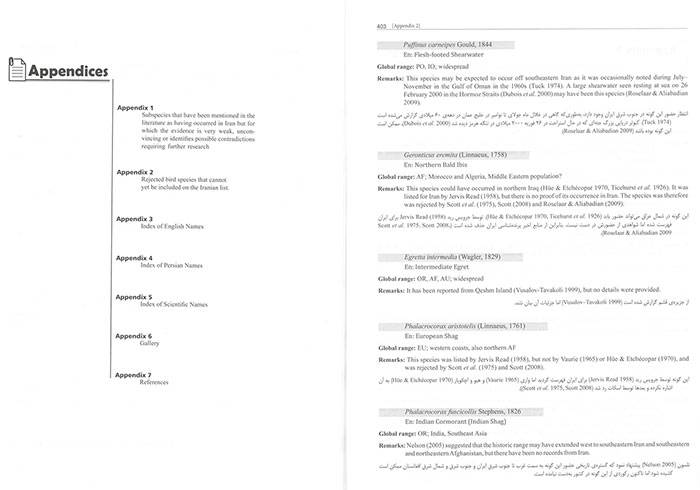
The book includes 80 beautiful photos of species most characteristic of Iran’s birdlife, but also some of vagrants, like Great Stone-curlew, Asian Koel, Spotted Owl, Sind Woodpecker, Long-tailed Shrike L schach, Ashy Drongo Dicrurus leucophaeus, Pleske’s Ground Jay, Grey Hypocolius, Oriental White-eye and White-winged Grosbeak.
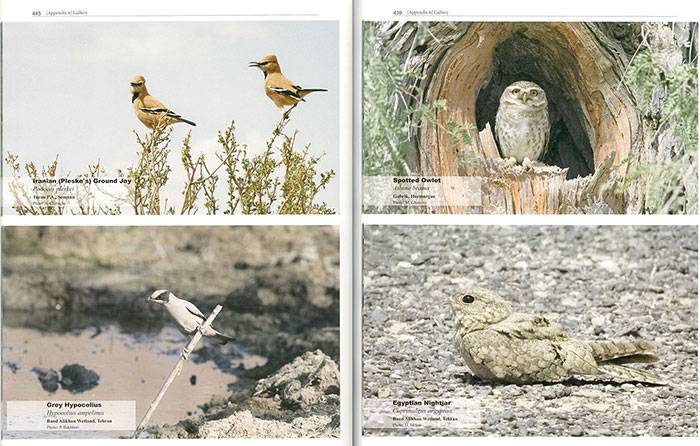
This publication does not contain species distribution maps, neither is it a guide to the most interesting birding sites in Iran. At the moment, however, it is the most comprehensive book on the birds of this country and may provide a starting point in the search for detailed information or for planning a trip to this fascinating country.
The authors are to be congratulated for the immense effort they have put into preparing this book. It will be very useful to everyone interested in the WP’s birds, certainly to birdwatchers who would like to visit Iran. This surely applies to, when I will go there next year for ‘Omid’, Pleske’s Ground Jay and other Iranian specialities.
Unfortunately, the book is not available for sale on the European market. Should you be interested in purchasing a copy, please contact the publisher – Iranshenasi Publishing – via email: info@iran-shenasi.com.
Łukasz Ławicki
References
Alieslam, A. 2014. First record for Iran of Black-naped Monarch Hypothymis azurea, near Jask city, Hormozgan province. Sandgrouse 36: 61-62.
Ayé, R. 2008. Saxaul Sparrows in Iran in April 2004. Dutch Birding 30: 315-316.
Ayé, R., Roth, T. & Stalling, T. 2014. Paddyfield Pipit (Anthus rufulus) in south-eastern Iran: a species new to the Middle East. Zoology in the Middle East 60: 183-185.
Ayé, R., Stalling, T. & Roth, T. 2014. Himalayan Vultures in Iran in April 2007 and December 2010. Dutch Birding 36: 159-161.
Barani-Beiranvand, H., Aliabadian, M., Irestedt, M., Qu, Y., Darvish, J., Szekely, T., van Dijk, R. & Ericson, P. 2017. Phylogeny of Penduline Tits inferred from mitochondria and microsatellite genotyping. Journal of Avian Biology 48: 932-940.
van den Berg, A.B. 2018. WP bird names. Website: https://www.dutchavifauna.nl/page/1209/wp_vogelnamen.
Campbell, O., Smiles, M., Roberts, H., Judas, J. & Pedersen, T. 2017. Gulf of Oman: analysis of seabird records of boat trips from the east coast of the United Arab Emirates 2010-2016. Sandgrouse 39: 138-165.
Cheraghi, S. & Tohidifar, M. 2010. First record of Ultramarine Flycatcher Ficedula superciliaris in Iran and the Middle East. Sandgrouse 32: 37-38.
Cramp, S. & Simmons, K.E.L. (editors) 1977. The birds of the Western Palearctic 1. Oxford.
van Diek, H., Felix, R., Hornman, M., Meininger, P.L., Willems, F. & Zekhuis, M. 2004. Bird counting in Iran in January 2004. Dutch Birding 26: 287-296.
van Els, P. & Brady, M.L. 2014. Specimen of Indian Pitta Pitta brachyura from the Islamic Republic of Iran. Bulletin of the British Ornithologists’ Club 134: 160-162.
Foekens, E. & Schelvis, J. 2006. Two River Terns in Golestan, Iran, in January 2005. Dutch Birding 28: 21-23.
Gholamhosseini, A., Aliabadian, M., Darvish, J., Töpfer, T. & Sætre, G.-P. 2017. An expanding hybrid zone between Black-headed and Red-headed Buntings in northern Iran. Ardea 105: 27-36.
Khaleghizadeh, A., Scott, D.A., Tohidifar, M., Babak, S., Musavi, M.G., Sehhatisabet, M.E., Ashoori, A., Khani, A., Bakhtiari, P. & Amini, H. 2011. Rare birds in Iran in 1980-2010. Podoces 6: 1-48.
Ławicki, Ł. & Tizrooyan, H. 2018. ‘Omid’: last wild Siberian Crane in the WP. Dutch Birding 40: 247-252.
Martins, R.P. & Hirschfeld, E. 1998. Comments on the limits of the Western Palearctic in Iran and the Arabian Peninsula. Sandgrouse 20: 108-134.
Mitchell, D. 2017. Birds of Europe, North Africa and the Middle East. An annotated checklist. Barcelona.
Musavi, S.B., Khani, A., Khaleghizadeh, A. & Robb, M. 2016. The first confirmed records of Omani Owl Strix butleri (A.O. Hume, 1878) (Aves: Strigidae) from Iran. Zoology in the Middle East 62: 1-4.
Roselaar, K. 2006. The boundaries of the Palearctic region. British Birds 99: 602-618.
Roselaar, C.S. & Aliabadian, M. 2009. Review of rare birds in Iran, 1860s-1960s. Podoces 4: 1-27.
Roth, T., Ayé, R., Burri, R. & Schweizer, M. 2005. Bird observations from Iran in February-March 2001, including a new species for the Middle East. Sandgrouse 27: 63-68.
Scott, D.A. 2008. Rare birds in Iran in the late 1960s and 1970s. Podoces 3: 1-30.
Shokouhi, A., Bakhtiari, P. & Khaleghizadeh, A. 2018. First confirmed record of the Bank Myna Acridotheres ginginianus from Iran with previous reports from the Tehran urban environment. Sandgrouse 40: 36-37.
Shirihai, H. & Svensson, L. 2018. Handbook of Western Palearctic birds: passerines. London.
Winkel, E., Amini, H., van Roomen, M. & Schelvis, J. 2010. Bird counting in Iran in January 2009. Dutch Birding 32: 172-188.
Ullman, M. 2009. Iran and the Western Palearctic. British Birds 102: 139–141.
Zarundy, N.A. 1911. Verzeichnis der Vögel Persiens. Journal für Ornithologie 59: 185-241.
Zekhuis, M. & Ghasemi, M. 2009. Status and distribution of Oriental White-eye in Iran. Dutch Birding 31: 230.

